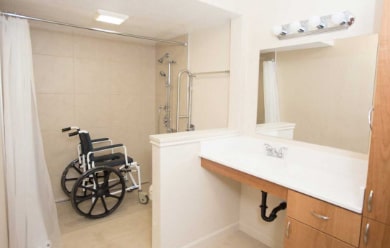1. ADA guidelines do not apply to the home setting.
The United States Access Board states, “These enforceable standards apply to places of public accommodation, commercial facilities, and state and local government facilities” (https://www.access-board.gov/guidelines-and-standards/buildings-and-sites/about-the-ada-standards). The next time you have a contractor work on your home for either you or a family member with a disability and the contractor starts to use the term “ADA”, ask them what their experience is working on ADA jobs in non-residential and residential arenas just to see if your situation would benefit from ADA guidelines.
2. ADA design and specs is a cookie cutter approach.
Often, people with high medical needs such as those who have had a stroke, spinal cord injury (SCI), brain injury, or ALS require custom home modifications. Why would a person who has a high-level SCI and no functional use of upper and lower extremities, require grab bars at ADA specifications installed in their bathroom that they cannot physically use? They don’t, there isn’t a need to install them – though it is always a good idea to install blocking for future grab bar use if you are going to be building new walls anyways. Don’t get me wrong ADA is better than nothing and it is a good foundation to start from, though its a guideline and will not suit everyone’s needs.
Example: We had a client with a spinal cord injury that was 6 feet tall. Her routine was to use the toilet, then shower immediately after. She did this for hygiene and routine reasons because it just made sense to bath after using the toilet. She also did this because it provided an opportunity for her to be reclined in her chair afterwards as some people who have had a SCI have a difficult time regulating their blood pressure, especially after a bowel movement, which is known as a vasovagal episode. Compound this with medications and a full stomach after breakfast equals the possibility of passing out. Our client had general contractors come in and redesign the bathroom to ADA specs which included a 60″x30″ minimum roll in shower. This might have sufficed for other people, though in her situation she was 5’6″ long when reclined in her shower commode wheelchair after using the toilet in order to increase her blood pressure and prevent dizziness and fainting. Add on a couple more inches for the wheelchair leg rests and handles in the back and her total length was coming out to almost 6 feet.
Ultimately she had to bath perpendicular to the shower with her feet and half of her body protruding out into the bathroom as the ADA designed bathroom that her contractor made, did not address her specific medical needs. She contacted us at Thrive for Life LLC and we created a design that provided more comfort and accessibility, while at the same time addressed her medical needs and her caregivers’ needs.
3. ADA design can end up costing more.
When remodeling for accessibility, it is critical to employ a designer who is experienced, educated and knowledgeable in creating modifications for residents with disabilities. Those of us who have this expertise can create a customized space without the cost of unnecessary modifications or even worst, having to redo the bathroom all together.
Two areas where money is unnecessarily spent in a remodel include:
1. Installing items that are not needed like grab bars for someone who cannot complete transfers.
2. Installing 36″ doors. This is a common misconception that all doors need to be 36″ wide, when, in reality, it’s the door width opening that matters. If a resident has a 32″ door and we can install swing-away hinges and achieve 32″ of space, then the doorway is ADA compliant. We work with contractors all the time that say, “So you’re gonna need 36″ doors everywhere, correct?” This depends. If a caregiver uses a 16″ wide transport chair to push a resident around the house, and we don’t have any 90-degree left or right turns in order to access the bathroom or rest of the home, then no we will not need any 36″ doors that yield “at least” a 32″ door width opening. This is because a 16″ transport chair with small wheels in the front and back, will be at most 20″ wide, putting money back in your pocket instead of widening doors that you do not need.
***HACK TIP*** If you have a walker and you cannot get through some doorways in your house and all you need is a couple of inches, try this. Switch the 2 front wheels, so put the right wheel on the left leg and the left wheel on the right leg and you will instantly have a walker that is 2″-4″ narrower.
